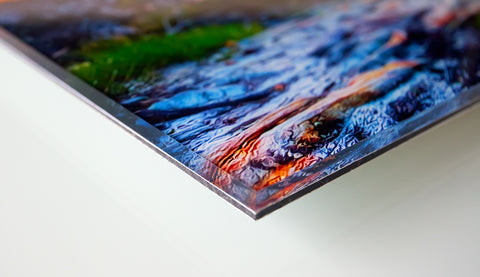Wood Frames
Although it may not the most economical, but absolutely the favorite and best looking. There are endless frame styles to choose from.
Older styles of frames were all made from wood. Wood brings an elegance that can not be equally matched by metal or plastic frames. Wood frames can be modern, contemporary, traditional, ornate, rustic, gold leafed, classic, or any combination of these styles. Some styles also come in various colors and finishes, such as matte, glossy or stressed etc.
There is a difference between hardwood and softwood frames as well. American hardwood frames are more desirable and include maple, cherry, walnut and ash. Also, do not confuse a walnut frame with a “walnut finish” frame, which usually is a softwood frame with a walnut stain.
Softwoods include cedar, pine and redwood. Some soft hardwoods are mahogany, ramin and basswood. Softwoods are less expensive because they scratch more easily and are more prone to warping. They also do not have well defined grain patterns as hardwoods.
We do not manufacture custom mouldings but we work with an array of moulding brands you are sure to find the perfect fit.

Metal Frames
Most metal frames consist of a very modern or industrial look. That does not necessarily mean the artwork has to be modern or contemporary.
If budget is a concern, metal frames are usually easier on the wallet. For thousand of years, wood frames have reigned as the only option for framing. We wouldn’t say metal frames are taking over, but it is indeed making its mark.
By placing a traditional painting into a metal frame, this means you’re thinking outside the box and being different. Sometimes it works, sometimes not so much.
Choosing a metal frame can either complete the look or completely ruin the piece. Nevertheless, our experts are here to guide you through this process.
We carry metal frames from Décor Moulding and the entire line of Nielsen aluminum frames.

Plastic Frames
These are made from a plastic called polystyrene, AKA wood imitation. They are painted and shaped to look like wood, but it is much lighter.
Here at 567 Framing, we do not provide plastic frames because of issues with production. With our high-powered cutting machines, badly manufactured polystyrene mouldings may “melt” as a result. Also, they may feel and look “cheap” but only if held in your hands.
Plastic frames are usually glued together and because of this, it cannot be used for larger pieces with glass. Wood screws can be used as well.
Frames sold online may consist of these types of frames because they can be inexpensive. When ordering a premade frame online, be sure to check the material before you click confirm order. These may also be good for DIYers.
Face Mounting (Frameless)
When you apply acrylic to the face of a print, this process is known as face mounting. It is becoming increasingly popular for its vibrant ultra-modern look. Because it does not require a frame or additional glazing, once up on the wall it looks like a piece of floating artwork – hard to achieve with framed pieces.
Not all types of paper can be successfully face mounted. High gloss or metallic papers are best since the surface tends to be very smooth and consistent. Do not attempt to face mount any papers with texture as the adhesive will not work on these and will leave bubbles. Once you make a first attempt, the artwork will be ruined if unsuccessful.
For the backing, it can be another pieces of plexi, Sintra or Dibond depending on the style you like or your budget. For easy hanging, we add a wood brace.
Note that this is a permanent process, so we prefer to only face mount prints, and only prints that may be reprinted in case the first attempt is not 100% perfect.

Canvas Stretching
This may not be a “frame” per se, but maybe the invert. Rather than an outer frame that’s used to protect the canvas, the canvas is wrapped over stretcher bars which is a wooden frame.
Stretcher bars come in 1/2” to over 2” thicknesses. This can be easily decided based on the size of the canvas, borders on the canvas, or how much more or less dramatic you’d like it to be. A determining factor also is whether or not you would like it framed after it is stretched. This is a matter of preference, there is no right or wrong.
To prevent warping of the wood, we always use crossbars to strengthen the frame. Staples are used to secure the canvas in place. They are normally made from pine or fir.
For more refined pieces, you may also add a linen liner. It acts as a “mat” for a painting on canvas.
Metal stretcher bars are relatively new to the art market. They are for much larger canvases because they are lightweight and for stability. We do not offer these services at this time.
In the next blog, we will discuss how to stretch a canvas of your own!

